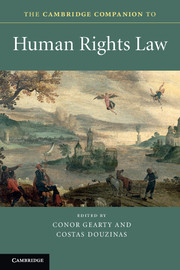Book contents
- Frontmatter
- Contents
- Preface
- Notes on contributors
- Acronyms and abbreviations
- Introduction
- Part I All kinds of everyone
- Part II Interconnections
- Part III Platforms
- Part IV Pressures
- 14 Winners and others: accounting for international law’s favourites
- 15 Resisting panic: lessons about the role of human rights during the long decade after 9/11
- 16 What’s in a name? The prohibitions on torture and ill treatment today
- 17 Do human rights treaties make enough of a difference?
- Index
- References
16 - What’s in a name? The prohibitions on torture and ill treatment today
from Part IV - Pressures
Published online by Cambridge University Press: 05 December 2012
- Frontmatter
- Contents
- Preface
- Notes on contributors
- Acronyms and abbreviations
- Introduction
- Part I All kinds of everyone
- Part II Interconnections
- Part III Platforms
- Part IV Pressures
- 14 Winners and others: accounting for international law’s favourites
- 15 Resisting panic: lessons about the role of human rights during the long decade after 9/11
- 16 What’s in a name? The prohibitions on torture and ill treatment today
- 17 Do human rights treaties make enough of a difference?
- Index
- References
Summary
Torture constitutes one of the most serious human rights violations and a direct attack on the core of the dignity and integrity of human beings. As a consequence, the prohibition of torture has been recognised as one of the very few absolute and non-derogable rights in a variety of global and regional human rights treaties. It also has been accepted as a rule of ius cogens under international law, in times of both peace and armed conflict. Nevertheless, after having carried out the mandate of UN Special Rapporteur on Torture for six years and having conducted fact-finding missions to eighteen countries in all world regions as well as three joint studies with other special procedures, I have come to the conclusion that torture is practised in more than 90 per cent of all countries and constitutes a widespread practice in more than 50 per cent of all countries. In addition, I have found highly deplorable conditions of detention in most countries that often amount to cruel, inhuman or degrading treatment. I was so alarmed by these findings that I have spoken of a global prison crisis and have called for a UN Convention on the Rights of Detainees.
In reaction to the systematic practice of torture in Latin American military dictatorships the UN in 1984 adopted the special Convention against Torture and Other Cruel, Inhuman or Degrading Treatment or Punishment (CAT) aimed at strengthening the prohibition of torture and ill treatment through a number of positive obligations to prevent torture, to criminalise torture and bring the perpetrators of torture to justice, and to provide torture survivors with an effective remedy and reparation for the harm suffered.
- Type
- Chapter
- Information
- The Cambridge Companion to Human Rights Law , pp. 307 - 328Publisher: Cambridge University PressPrint publication year: 2012
References
- 6
- Cited by



